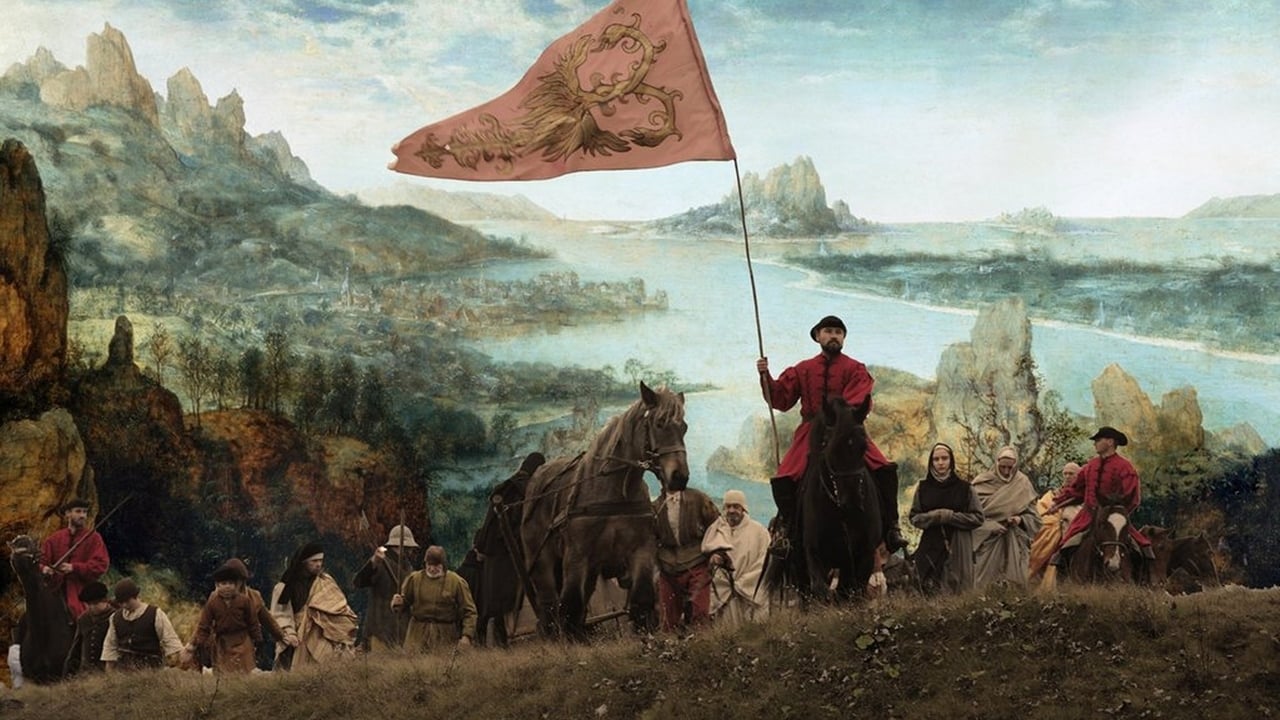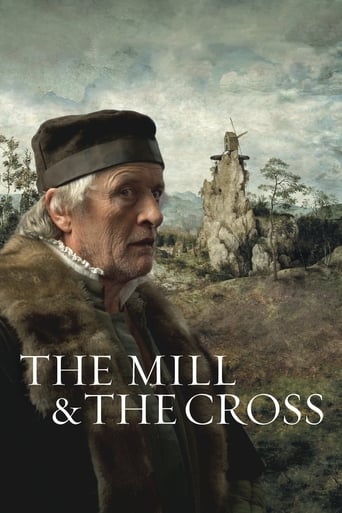



One of the best films i have seen
Blending excellent reporting and strong storytelling, this is a disturbing film truly stranger than fiction
View MoreThe movie really just wants to entertain people.
There is, somehow, an interesting story here, as well as some good acting. There are also some good scenes
View MoreThe movie begins with the awakening of Renaissance citizens (individuals, families or groups) who, once clothed and fed, go around their daily business. Young siblings tease each other, woodsmen cut down a tree, a musician plays a tune. It is not long before atrocious violence rears its head : red-coated men grab a young peasant and whip and beat him unmercifully, before tying him to an execution wheel. His despairing wife crawls around the place of execution without obtaining help or solace. Slowly it becomes clear that the characters - violent or peaceful, young or old, bereft or happy - all share a common bond : they are closely connected to a painting called "The way to Calvary". This painting, celebrated for its deep insight and subtle symbolism, was made by Breughel the Elder.In the painting, Breughel used the passion of Christ in order to explain and examine the horrors of his time, just as he used the horrors of his time in order to explain and examine the passion of Christ. Thus "The mill and the cross" is an exploration of at least three subjects. There's the torture and execution of Jesus Christ, as described by the New Testament ; there's the painting made by Breughel ; and there's the life of the painter, who was unlucky enough to live through some VERY interesting times, complete with war, tyranny, doctrinal schism and religious violence. In lesser hands this could have meant a complete muddle, but the movie succeeds in combining all of these elements into a cohesive and harmonious whole. The movie is a feast for the eyes, thanks to a very innovative combination of computer-generated effects, painted backgrounds and hand-picked locations. (The costumes too are superb.) But it is first and foremost a meditation on religious, theological and moral themes. Which is as it should be...I recommend the movie to everyone, even to readers who are not Catholic or Christian. The movie touches upon universal themes, such as the nature of Mankind's seemingly eternal capacity for mischief. (It is not a coincidence that some of the worst enormities are committed by followers of what is supposed to be a religion of peace and unity.) However, I would like to give you one advice and that is not to watch the movie in the company of a professional (art) historian. Breughel lived a long time ago and his work was drenched in a very subtle symbolism, meaning that it can be analyzed and reviewed "ad vitam aeternam". You, dear reader, don't want to hear a continuous comment on the 1001 alternative interpretations of the yellow frock on the left or the little dog on the right...
View MoreThe Mill and the Cross certainly is a visual spectacle. With its very elaborate scenery and the painstaking efforts that went into the recreation of the painting, it's a technical masterpiece.Sadly, that's all that can be said in favor of the film.The storyline, if there really is any, jumps around from scene to scene in a seemingly random manner. None of the characters really interact and the acting is more like posing for a painting than acting. That might have been the goal, but it doesn't work here. In a sense, it's really not a movie but it rather has the style of a dramatized documentary.But it isn't a documentary either. At no time was any care given to real historical realism. In the film a reference is made to the city of Antwerp, but the city you can visit today (and please do, I'll give you a tour) looks more historically representative of the era than the film. I read and heard that enormous care was given to elements like the choice of the right kind of materials for the clothing. That may be true. But it brings nothing to the film as an experience, nor is it informative in any way. I read reviews where the reality with which the way of life in 16th century Flanders was depicted is greatly applauded. They are misguided. None of the building style, interiors, music or daily customs depicted are found anywhere in 16th century Flanders. They look like 13th century Poland. Because a lot of it was shot there. The landscape may resemble that of the painting, but clashes with reality. You might argue that it was the film maker's intent to closely resemble this highly symbolic painting. And I would agree. But he does this with great superficiality. It would have been much more interesting to show and contrast 16th century reality with the symbolism in the painting. But the director seems unable or unwilling to make the distinction. And thus we are left with a succession of 'tableaux' that visually resemble what's on the painting, with no reference to reality, then or now.You might argue that the director put in a lot of symbolism, some of his own. But the way the director tries to cram every pixel (the film was recorded digitally) with symbolism seems random too: a bit like a poet who believes his job is done when his sentences rhyme in a pleasing way, never mind the content. Sometimes he even attempts to be critical or sarcastic. Watching the scenes near the end where people are dancing and singing is downright painful. But there is no message in this. No-one cares? Life goes on? Life is hard and then you die? One person might call it an ode to the resilience of the ordinary people, but it might also be a protest against the callousness of the masses. The film takes no position.The director seems to know exactly what certain markets expect in terms of 'historical Europe' but seems to have no interest in the history and culture itself.If you are interested in a better film where symbolism, tempo, acting and story have a meaning, then I refer you to a real masterpiece about art, oppression and persecution: Andrei Rublev by the Russian master Andrei Tarkovski.
View MoreThis is simply a fake.Nothing close to Bruegel whatsoever. Bruegel's colors are transparent and clear, lighting is soft. He applied thin layers of paint to achieve this effect. In the movie, on the contrary, colors are running rampant in the most tasteless computer generated sort of way.Bruegel's palette is certainly not bright. Maybe the director had Flemish 15th century art with its bright colors in mind? But no, he didn't. Flemish masters used glazing to let the light travel through multiple layers of paint to achieve marvellous illusions of tangibility and depth. In the movie though, the colors seem to be borrowed from a candy store. Bold and artificial. Everything in this film is digitally enhanced but acting. Acting is a pure zero while the visuals are a zero digitally enhanced.The lighting indoors reminds of Caravaggio at best, but it's way too crude. The first scene with the lovers is lit with Caravaggio in mind but the director decided to throw in a bit of Flemish Art. Hence a brightly lit window. Unfortunately, the result is a caravagesque painting torn and another one, Flemish, visible through a hole.So, what's this film about? Spanish oppression. Well, with no plot, no acting, no drama it's a worthless comment. About the recreation of Bruegel's famous painting? No way. The painting is shown in the movie and it's obvious that it has nothing to do with it artistically. Well, even though out of place, could it be on Barogue art? The lighting indoors is certainly meant to be Baroque. That can be true but than the director has not succeed. If you are interested in Baroque, there are quite a few infinitely better films. Even an entertaining and unpretentious "Alatriste" succeeded in recreating Velasquez way better than "The Miller and the Cross" in recreating anything.This film is nothing but European artsy pop junk. Will there be an end to artsy directors fooling the public? I gave the movie two stars because at least some viewers might get interested in Pieter Brugel's art after seeing a "Road to Calvary" painting.
View MoreMany thanks to the Rotterdam filmfestival 2011 for screening this guided tour through Christ Carrying the Cross, the painting by Pieter Bruegel the Elder. I learned a lot about the ideas behind it and the way it was set up. Seeing it explained gradually throughout the story, will let me remember it better than reading about it in a book.We also learned a lot about how people lived those days. A special mention should be devoted to the parts where this film demonstrates that life goes on, regardless of politics, war, and religions. We also saw many forgotten customs about bread, threshold cleaning, and much more that I want to leave as an exercise to the close observer.A dramatic moment at ¾ of the film is where the painter raises his hand, and life comes to a stand still, including the mill on the hill that stops by a hand signal of the miller. It seems no coincidence that the miller very much resembles how our Lord is pictured usually, and also that he oversees the whole panorama from his high position. As soon as he signals the mill to resume working, the whole picture relives from its frozen state.A large part of the audience stayed for the final Q&A. We got much information about the post production effort required to get the colors right, and creating the different layers to get everything in focus. Further, the film maker told he wanted to make a feature film from the start. It was considered a Mission Impossible by the people around him. How wrong they were!All in all, a lot goes on in the film, much more than I could oversee during the screening. Maybe I should try to grasp more of the fine details during a second viewing. I don't think I saw everything that the film makers did put into this production.
View More